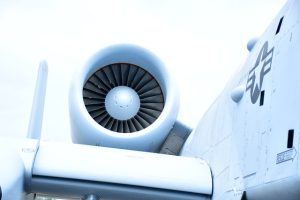
Turbofan engines are synonymous with modern-day airplanes. Also known as fanjets, they are airbreathing engines that generate propulsion by releasing a stream of air and combustion gas out a nozzle. Most commercial airplanes are powered by turbofan engines. While they all use a similar method of operation, though, there are several different types of turbofan engines. Below are three of the most common types of turbofan engines and how they work.
#1) Low Bypass
There are low-bypass turbofan engines. As the name suggests, it’s characterized by a low bypass ratio. All turbofan engines have a bypass ratio. It represents the ratio of the air mass that “bypasses” the core of a turbofan engine.
Turbofans have an intake that sucks air into the core. Upon entering the core, it’s mixed with fuel and ignited. But some of the air will go around the core. Bypass ratio represents the amount of air that goes around the core relative to the amount of air that enters the core.
#2) High Bypass
There are also high-bypass turbofan engines. High-bypass turbofan engines have a high bypass ratio. They are more common than low-bypass turbofan engines, especially in the commercial aviation industry. Most commercial airliners are powered by high-bypass turbofan engines.
Why are high-bypass turbofan engines preferred over low-bypass turbofan engines exactly? The main advantage of high-bypass turbofan engines is efficiency. They are more fuel efficient than low-bypass turbofan engines, resulting in cost-savings benefits for commercial airlines and recreational pilots.
#3) Afterburner
In addition to low- and high-bypass turbofan engines, there are afterburner turbofan engines. They are typically used in military jets. Afterburner turbofan engines feature an afterburner, which is found downstream of the fan blades.
All turbofan engines have fan blades. Afterburner turbofan engines, however, feature an afterburner downstream of these fan blades and upstream of the exhaust nozzle. The afterburner works by burning a large amount of fuel and air, resulting in even hotter exhaust gases and, thus, more propulsion.
In Conclusion
Turbofan engines are jet engines that suck air into a core where it can be mixed and burned with fuel. A process known as combustion, this creates hot exhaust gases that are expelled out a nozzle. Common types of turbofan engines include low bypass, high bypass and afterburner.
Low-bypass turbofan engines have a low bypass ratio, meaning most of the air enters the core. High-bypass turbofan engines have a high bypass ratio, meaning most of the air goes around the core. Afterburner turbofan engines have an afterburner, allowing for short but powerful bursts of speed.



